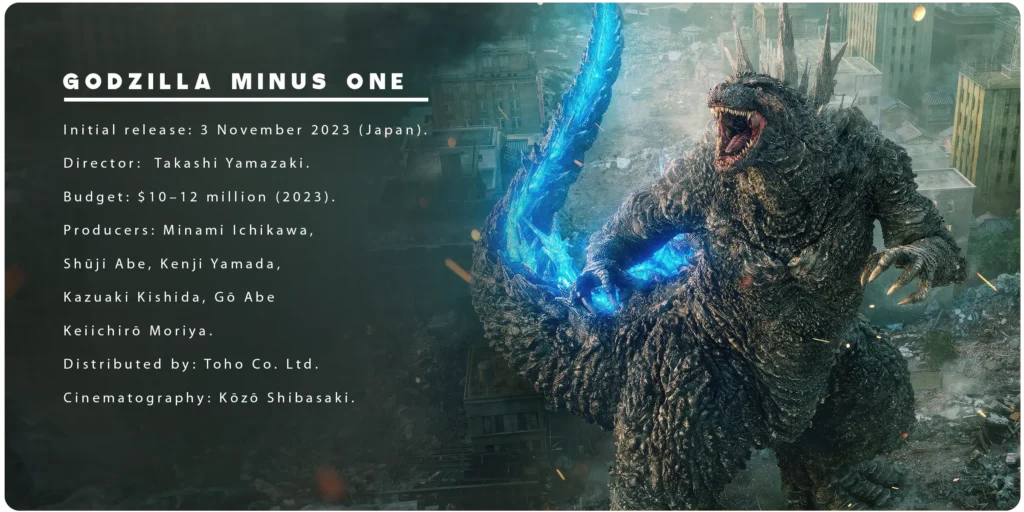Godzilla Minus One vs Adipurush: How a Low -Budget Film Outshines in VFX
A detailed case study of “Godzilla Minus One” and “Adipurush” reveals that “Godzilla Minus One” excels in filmmaking due to its balanced approach to storytelling, character development, and high-quality visual effects, making it more engaging and emotionally resonant. In contrast, “Adipurush” prioritizes grand visuals over narrative depth, resulting in a less cohesive and impactful film experience.

Learning from Godzilla Minus One: A Lesson for Adipurush
The film industry often witnesses stark contrasts in the success of movies with varying budgets. A notable comparison can be drawn between the Indian film “Adipurush” and the Japanese film “Godzilla Minus One.” Despite their differences in genre and cultural contexts, “Godzilla Minus One” provides valuable lessons for the makers of “Adipurush” on how to craft a compelling movie without an exorbitant budget.
When it comes to filmmaking, some directors believe in throwing money at a problem, while others rely on ingenuity and creativity. This stark contrast is beautifully illustrated in the comparison between “Adipurush” and “Godzilla Minus One.” Let’s dive into how “Adipurush” stumbled spectacularly with its astronomical budget, while “Godzilla Minus One” soared to success on a shoestring.

Adipurush: The $67 Million Misfire
“Adipurush” set out to be a cinematic extravaganza with a budget that could rival the GDP of a small nation, clocking in at a mind-blowing ₹500 crores (about $67 million USD). This lavish spending aimed to bring the epic Ramayana to life with stunning visuals and big-name stars like Prabhas and Saif Ali Khan. But as the saying goes, “money can’t buy taste,” and it certainly couldn’t buy good reviews or box office success in this case.
Despite its opulence, “Adipurush” managed to do what few films can: turn an epic tale into a lackluster snooze-fest. The film’s heavy reliance on CGI left it looking like a glorified video game cutscene rather than a heartfelt retelling of a beloved epic. The narrative was as bloated as its budget, with characters as two-dimensional as the green screens they were filmed against. With a worldwide gross of around ₹450 crores (approximately $60 million USD), it barely scratched the surface of breaking even. It’s a classic case of how to waste a whole lot of money for a whole lot of nothing.
When it comes to filmmaking, some directors believe in throwing money at a problem, while others rely on ingenuity and creativity. This stark contrast is beautifully illustrated in the comparison between “Adipurush” and “Godzilla Minus One.” Let’s dive into how “Adipurush” stumbled spectacularly with its astronomical budget, while “Godzilla Minus One” soared to success on a shoestring.

Godzilla Minus One: The Triumph of The Titans
Now, let’s turn our attention to “Godzilla Minus One,” a film that shows how to do things right with a fraction of the budget. Directed by Takashi Yamazaki, this gem was made with an estimated budget of around $10-15 million USD. Despite or perhaps because of its modest budget, the film roared its way into audiences’ hearts and box offices worldwide, grossing over $50 million USD.
“Godzilla Minus One” didn’t need a giant pile of cash to make a big impact. Instead, it relied on a tight script, well-developed characters, and innovative special effects that enhanced the story rather than overshadowed it. The practical effects and clever cinematography created a sense of authenticity and immersion that “Adipurush” could only dream of.

The Craft: Quality over Quantity
One of the primary lessons for the makers of “Adipurush” from “Godzilla Minus One” is the emphasis on quality over quantity. “Godzilla Minus One” leveraged its budget by focusing on a strong script, well-developed characters, and efficient use of technology. The film’s special effects, though not as lavish as those in “Adipurush,” were effectively utilized to enhance the storytelling rather than overshadow it.
“Adipurush,” with its heavy reliance on CGI and grandiose sets, sometimes lost sight of narrative coherence and character development. The film’s grandeur could not compensate for the perceived lack of depth in its storytelling, which ultimately affected its reception among audiences and critics alike.
Innovation and Resourcefulness
“Godzilla Minus One” exemplifies how innovation and resourcefulness can overcome budgetary constraints. The film utilized practical effects, clever cinematography, and meticulous planning to create an immersive experience. This approach not only kept costs down but also added a layer of authenticity to the film that resonated with audiences.
“Adipurush” could benefit from such an approach. By investing in strong writing, character development, and practical effects, future projects can achieve a more balanced and impactful cinematic experience. This shift in focus can help in maximizing the potential of the budget and ensuring that the storytelling remains at the forefront.
Conclusion
The makers of “Adipurush” should take a long, hard look at “Godzilla Minus One” to understand where they went wrong. Throwing money at special effects and star power doesn’t guarantee success. What truly matters is the heart of the story, the development of characters, and the intelligent use of resources.
In conclusion, “Adipurush” is a textbook example of how not to make a film, while “Godzilla Minus One” is a shining beacon of what can be achieved with a bit of ingenuity and a lot of heart. If future filmmakers take these lessons to heart, perhaps we’ll see more masterpieces born from modest means rather than epic disasters funded by colossal budgets.
Both “Adipurush” and “Godzilla Minus One” are now available on Netflix, providing an excellent case study in film budget management. “Adipurush,” with its staggering budget of ₹500 crores (about $67 million USD), showcases the pitfalls of relying heavily on CGI and star power without a strong narrative foundation, resulting in a mixed reception and underwhelming box office returns. In stark contrast, “Godzilla Minus One,” made with a modest budget of $10-15 million USD, emphasizes the power of strong storytelling, well-developed characters, and innovative use of practical effects, achieving critical acclaim and impressive financial success. Watching these films back-to-back on Netflix offers valuable lessons in how creativity and resourcefulness can triumph over sheer financial expenditure in filmmaking.

